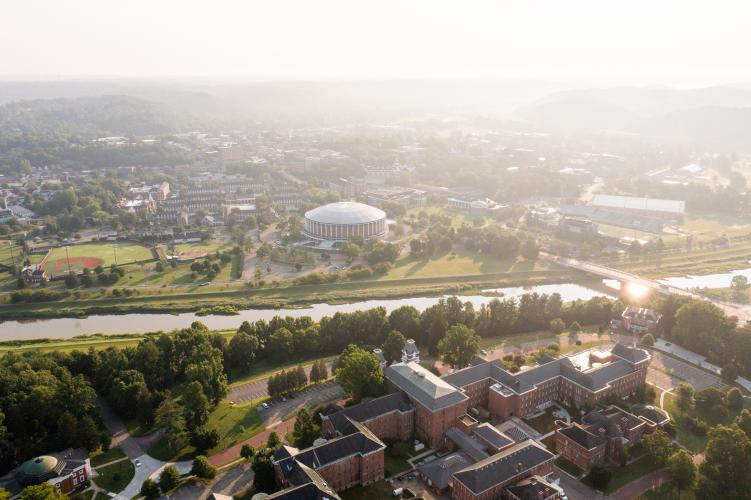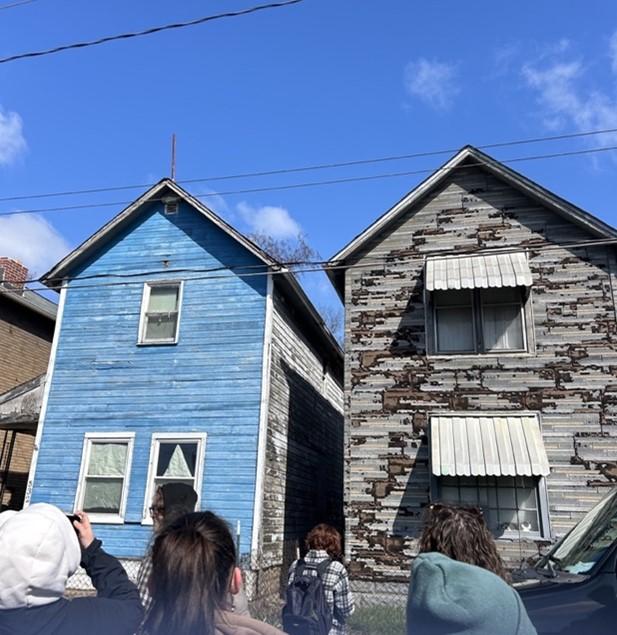

Note: This article was submitted by members of OHIO's Urban Planning Student Association
During our urban geography class in the College of Arts and Sciences at Ohio University, we talked about numerous urban occurrences like revitalization, gentrification, and the challenges of planning a fair and equitable city.
The field trip to Columbus was a great way to put all of what we learned into perspective and observe city planning projects firsthand.
As the fastest growing city in the United States, Columbus has experienced explosive growth in the past 10 years, which has raised questions about topics such as housing affordability, equitable development, transit and mobility, and downtown reinvestment. This field trip, led by OHIO graduate Kyle May, touched on nearly every one of these topics as we explored Franklinton, Downtown, the Arena District and the Short North.
From the start of the trip, there was an immediate observable difference in the landscape of Franklinton. The side of the road that One Line Coffee was on consisted of new, modern buildings. The other side of road included an art studio and buildings that had older architecture styles. The students in our group questioned if any buildings will have to be renovated, torn down and rebuilt, or sold to keep up with the development happening around them.
Another area that stood out on our tour was Walnut Street, where developer Blake Compton, a founder at Compton Construction, bought houses on the street to with the goal of turning the area into an “equitable and bohemian village.”
Compton explained to us that he knows every person who lives on Walnut Street and said that no residents are being blindsided or “kicked out” by this revitalization project. Compton plans for the houses on these streets to be turned into restaurants, theatres, and bars with residential apartments on the second floor of a few of the buildings. In theory, this project seems like a great idea, but we did leave with a few questions including if the new restaurants and other attractions on the street will raise the cost of living in the areas surrounding Walnut Street.
Our group was also fortunate to hear an excellent presentation by Jonathan Staker, a designer at MKSK. He talked about the creation of the new Columbus Crew stadium, and how the continued development in the Arena District will be designed to be accessible, encourage walking, and include mixed-use buildings and blocks. Sports centers can be big cultural attractors in cities, bringing in tourists, locals, and business.
For a growing city like Columbus to have a district dedicated to sports and entertainment is likely to be a successful venture, Staker said. He also brought up how sports centers often get abandoned when the season is over, so MKSK wants the stadium to be open for events outside of the season to keep the Arena District community active. Keeping the area busy year-round draws in more business opportunities and residents who crave living in a vibrant city.
For lunch, we headed to the North Market. To get to there from the Arena District, we walked over a path that was above a railroad. Columbus is one of the only major cities in the United States without a rail transportation system, but in the coming years, that will change.
We were told about the proposal for an Amtrak train that will have stations in Cincinnati, Columbus, and Cleveland. Columbus will likely benefit from being a part of the Amtrak rail networks. As for the North Market, it was filled with different vendors and small restaurants, many of them serving cultural foods from around the world.
During the final portion of our trip, we got to see highway caps in the Short North district. One of the highway caps was poorly designed, not pedestrian friendly, exposed the highway, and was very noisy. However, the other one, on High Street, worked very well.
The goal of this design was to encourage people to walk to High Street by making the path feel pedestrian-safe and secure by limiting access to views of the highway while crossing. It acts as a bridge, but if you were to walk along this part of High Street, you would not realize there is a freeway below. This is the way it should be. Highways are good transportation networks when they aren’t dividing or disrupting a city.


